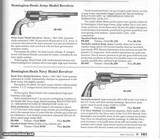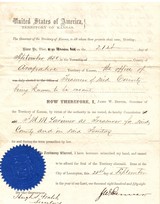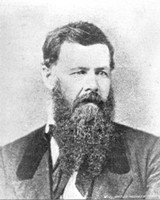 |
 |
 |
 |
 |
 |
 |
 |
 |
 |
 |
 |
 |
 |
 |

Remington-Beals Navy Model, Martially marked (RARE), 7-3/8" barrel, Inscribed to Gen William Larimer, Jr,
Guns International #: 102567350 Seller's Inventory #:
Category: Remington Revolvers - Antique - Civil War Pistols
Seller's Information
When emailing or calling sellers direct, please mention that you saw their listing on GunsInternational.com
Seller: dacotah
Member Since: 5/20/14
First Name: Keith
Last Name: Kristjanson
State: North Dakota
Zip: 58201-7916
Country: United States
Phone: (701) 740-7438
Number of Active Listings: 7
Total Number of Listings: 9
Seller: Private Seller
Return Policy: 3 day inspection and return policy on used guns.
No refunds for shipping charges. Returned items must be received in the same condition as originally shipped - cleaning, disassembly, alteration, or damage of any kind will void inspection privileges.
Payment Types Accepted: USPS MONEY ORDER, CERTIFIED FUNDS, CREDIT CARDS WITH 3% FEE DISCOVER/ VISA/MASTERCARD/AMERICIAN EXPRESS
Description:
Remington-Beals Navy Model, Martially marked (RARE), 7-3/8" barrel, Inscribed to Gen William Larimer, Jr,
NOTE:
Martially marked as follows:
"W' stamp on left flat of barrel just in front of frame, 2 "W" stamps on left side of frame, one just in front of the cylinder and the other on frame just next to grip, and one "W' stamp on the cylinder
"CGC" cartouche at base of left grip, (C.G. Curtis) who was principle sub-inspector at Remington June - August, 1862, and stamped his cartouche on each .36 Beals Navy and .44 Model 1861 Army pistol accepted fo4r the US Army
Three ORIGINAL documents:
1) ORIGINAL document appointing William Larimer, Jr.Brigadier General, of the First Brigade of the Eighteenth Division of the Uniformed Militia of the Counties of Allegheny, Armstrong, Indiana And Jefferson, until the First Monday of June 1854. Complete with attached Seal and dated June 4, 1849. Signed by Governor William F. Johnston and A.L. Russell as Secretary of the Commonealth of Pennsylvania.
2) Governor of the Territory of Kansas ORIGINAL document appointing Wm Larimer as Treasurer of Arapahoe County in the Territory of Kansas, complete with seal. Dated September 21, 1868.
3) Sworn ORIGINAL hand written oath of office and signed by Wm Larimer, Jr. for appointment as treasuer of Arapahoe County, Territory of Kansas. Signed and dated on the back of the appointment document.
William Larimer, Jr
Birth: Oct. 14, 1809
Gettysburg
Adams County
Pennsylvania, USA
Death: May 16, 1875
Fort Leavenworth
Leavenworth County
Kansas, USA
Denver Founder. General Larimer's birthplace is within the battle-field of Gettysburg. He moved to Pittsburgh where he became a merchant, a banker, and president of a short line of railroad. Larimer was appointed to the rank of major- general of the western division of the Pennsylvania militia. Larimer came to Nebraska in 1854 and was a member of the House of Representatives of the second legislative assembly. Also, as president of the Larimer City Town Company, he filed a certificate of the claim of the site of the company, comprising about 320 acres adjacent to the present LaPlatte, Nebraska, on July 20, 1857. In 1858 he moved to Leavenworth, Kansas, and in the fall of the same year he went to the Pike's Peak gold fields. He founded the upstart Denver City by crossing cottonwood sticks at the center of a square mile town plat on November 22, 1858. Larimer chose the east side of Cherry Creek because it was higher ground and on the more accessible side of the Cherry Creek and South Platte River trails. Larimer named the newborn metropolis for James W. Denver, governor of Kansas Territory, to help ensure that it would be chosen as the county seat of what was then Arapaho County, Kansas Territory. A principal street of the city and a county bear his name in Colorado as well as an avenue in Pittsburgh, Pennsylvania and a county there. In 1863, Larimer returned to Leavenworth where on August 12 became captain of Company A, Fourteenth Regiment Kansas Volunteer Cavalry and served until the regiment was mustered out on June 25, 1865. Though his physique was stunning, he rose to no higher rank than captain. The regiment was actively engaged in frontier warfare. Captain Larimer returned to Leavenworth at the end of the war. He was a radical abolitionist before he left Pennsylvania, and he championed the cause of woman suffrage in Nebraska, for which he suffered ridicule by politicians in general and J. Sterling Morton in particular. He joined the Liberal Republican movement in 1872, and was a candidate for the office of presidential elector on the Greeley ticket. He was president of the board of trustees of the institution for the blind at Wyandotte and a member of the board of managers of the reform school at Leavenworth. (bio by: Fred Beisser)
Search Amazon for William Larimer
Burial::
Leavenworth National Cemetery
Leavenworth
Leavenworth County
Kansas, USA
Edit Virtual Cemetery info[?]
Maintained by: Find A Grave
Record added: Apr 25 2004
Find A Grave Memorial# 8680739
Fiftyniners' Directory
Colorado Argonauts
1858-1859
LARIMER PARTY, this celebrated company arrived mouth of Cherry Creek Nov 16, 1858 by Santa Fe Trail, having left Leavenworth Oct 1. Member of the party were: Gen. William Larimer, Jr. and William H. H. Larimer (youngest of the party), R. E. Whitsitt (said to have been born in Ireland), M. M. Jewett of Massachusetts, Folsom Dorsett, a Kansas pioneer born in Indiana (and nephew of C. A. Lawrence), and C. A. Lawrence. (Another authority says that E. W. Wynkoop was of this company ?) They immediately began organizing Town Company called Denver City.
LARIMER, General William, one of the founders of Denver, was a native of Pennsylvania, at one time having been a candidate for Governor of that State. Was banker and railroad builder. He came to Colorado in 1858, and was a rival of Gilpin in having the Governor’s office in Colorado when it was established as a Territory in 1861. His residence in Pennsylvania was in Pittsburg, but he was known as well throughout Pennsylvania. Frank Hall gives a very fine notice of him in his Colorado History, Vol. II, p. 241. His portrait is on p. 1 (with wife) of Reminiscences of General William Larimer edited by William Larimer Mellon of Philadelphia 1918. (Also on p. 85 of same book is a portrait taken in 1852.) Another portrait is on p. 139 of this book, one taken several years after the others. He died at his residence in Deleware Township, Kansas May 16, 1875, aged about 68 years. While in Denver he is said to have lived at corner of 15th and Larimer Streets. In the war of the Rebellion he was Colonel of the Third Colorado Regiment. In 1864 he left Colorado and raised a Regiment of Kansas volunteers, and commanded this regiment. It is said that General Larimer’s claim was next to that of his son, and is the present site of the State Capitol. This claim was ‘Jumped’ during the General’s absence. He had two lots in Denver (place not specified), which were held by the family until 1906 when they were sold for benefit of his daughter, Annie, by his son-in-law Mr. Mellon for $100,000.
LARIMER, William Jr., was treasurer of the Denver City Town Company Nov 22, 1858 (Smiley) and lived in Auraria in Jun 1859 when he was a delegate from that city to the first Constitutional Convention. (Another authority says he was a delegate from City of Denver ?) He is said to have had a claim near Denver with mound, call “Pilot Knob,” now known as “Grasshopper Hill.” It was jumped while he was in Leavenworth in 1859 or 1860. His portrait is in Smiley’s History of Denver, p. 213, and in Larimer Reminscences, p. 221.
LARIMER, William H. H., (William Henry Harrison ?), arrived with Larimer party 1858, and was a stockholder of Denver. In 1890 is resident of Kansas City, Missouri also in 1918. His notes of their trip make the book of reminiscences of General William Larimer. His portrait is published in Smiley’s History of Denver, p. 221, and in Larimer Reminscences, p. 184.
The first claim jump of Denver
Two rival groups competed to start a city where a river and a creek met. Being there made all the difference to Denver's founding.
By Dick Kreck
Special to The Denver Post
Posted: 11/21/2008 12:30:00 AM MST
Updated: 11/21/2008 12:23:54 PM MST
The Denver Central Library (Helen H. Richardson | The Denver Post)
Related
- Denver at 150
- Nov 25:
- "Imagine" Denver's 150 years
- Nov 23:
- City high on years, heroes
- Nov 21:
- Hard times not new for Denver
And it is only the latest chapter of a long tale set at the confluence of Cherry Creek and the South Platte River.
Indians, of course, had been camping and gathering on that spot for millennia, long before whites "discovered" the area in the 1840s as persistent rumors of gold got their attention. Mining camps like Montana City, "the old Mexican Diggings" and Placer Camp sprang up and disappeared along the Platte near present-day Overland Golf Course.
It was left to William Green Russell and his party of Georgians to establish, in November 1858, the first significant white settlement on a
150 years of Denver
- Browse the latest as well as historical photos of our city.
Other entrepreneurs, sure that a major gold discovery was just around the corner and that the site would bring thousands into the region, joined them. An estimated 300 people lived in the area by December 1858.
That same year, Charles Nichols and his party from Lawrence, Kan., arrived and decided to found a town, on a nearby tract. Fact is, under public-land laws the land belonged to the Indians, including the Arapaho.
No matter. On Sept. 24, 1858, they declared 640 acres east of Cherry Creek to be a new town site, first called Golden City, then changed to St. Charles. Most of the party went back to Kansas, leaving Charles Nichols to keep an eye on the town, which consisted of nothing but a "four-log improvement" — four logs laid out in a square to indicate the founders' intentions.
That November, William H. Larimer Jr. and a group of his well-armed buddies from Auraria "jumped the St. Charles site, telling Nichols that if he objected 'a rope and a noose would be used on him,' " wrote Thomas Noel and Stephen Leonard in "Denver: Mining Town to Metropolis."
Hoping to get the approval for their bold move from Kansas Territory governor James W. Denver, they named the new, enlarged town "Denver City."
Unfortunately for them, the governor had resigned his post before their appeal reached him. Nevertheless, the Denver City Town Co. was organized on Nov. 22, 1858, and the founders — Bassett, Wynkoop, Blake, McGaa, Larimer, Lawrence, Curtis and Welton — named the still-unbuilt streets after themselves. Their newly established stagecoach depot, "vital in the making of a city," assured that Denver, not Auraria, would prevail.
And so it did. By 1860, the census showed 34,231 whites living in the area. Thousands more passed through on their way to the gold fields. It would be a while before the city became civilized. In the mid-1860s, a touring English clergyman found that "it was quite usual for honest folks to be awakened from their sleep by the noise of exploding guns, and when daylight came to find that a dead body had been tossed from a window into the street," Noel and Leonard recounted.
The fledgling town survived fire, flood and hordes of grasshoppers, but one thing was lacking — fast, reliable transportation from Eastern cities.
Denver, Colorado
City History
Denver was founded during the Pikes Peak Gold Rush in the Kansas Territory in 1858. That summer, a group of gold prospectors from Lawrence, Kansas arrived and established Montana City on the banks of the South Platte River. This was the first settlement in what was later to become the city of Denver. The site faded quickly, however, and was abandoned in favor of Auraria and St. Charles City by the summer of 1859.
On November 22, 1858, General William Larimer, a land speculator from eastern Kansas, placed cottonwood logs to stake a claim on the hill overlooking the confluence of the South Platte River and across the creek from the existing mining settlement of Auraria. Larimer named the town site Denver City to curry favor with Kansas Territorial Governor James W. Denver. Larimer hoped that the town's name would help make it the county seat of Arapaho County, but ironically Governor Denver had already resigned from office. The location was accessible to existing trails and was across the South Platte River from the site of seasonal encampments of the Cheyenne and Arapaho. Larimer, along with associates in the St. Charles City Land Company, sold parcels in the town to merchants and miners, with the intention of creating a major city that would cater to new emigrants. Denver City was a frontier town, with an economy based on servicing local miners with gambling, saloons, livestock and goods trading. In the early years, land parcels were often traded for grubstakes or gambled away by miners in Auraria.
The Colorado Territory was created on February 28, 1861, Arapahoe County was formed on November 1, 1861 and Denver City was incorporated on November 7, 1861. Denver City served as the Arapahoe County Seat from 1861 until consolidation in 1902 and then in 1865, Denver City became the Territorial Capital. With its new-found importance, Denver City shortened its name to just Denver. On August 1, 1876, Denver became the State Capital when Colorado was admitted to the Union.
Between 1880-1895 the city experienced a huge rise in city corruption, as crime bosses, such as Soapy Smith, worked side-by-side with elected officials and the police to control the elections, gambling, and the bunko gangs. In 1887, the precursor to the international charity United Way was formed in Denver by local religious leaders who raised funds and coordinated various charities to help Denver's poor.
Denver hosted the 1908 Democratic National Convention to promote the city's status on the national political and socio-economic stage. Denver was also later selected to host the 1976 Winter Olympics to coincide with Colorado's centennial celebration, but Colorado voters struck down ballot initiatives allocating public funds to pay for the high costs of the games, so the games were moved to Innsbruck, Austria. The notoriety of becoming the only city ever to decline to host an Olympiad after being selected has made future bids difficult.
Denver has also been known historically as the Queen City of the Plains because of its important role in the agricultural industry of the plains regions along the foothills of the Colorado Front Range. Several US Navy ships have been named USS Denver in honor of the city.
Price: $29,500.00
Antique: Yes